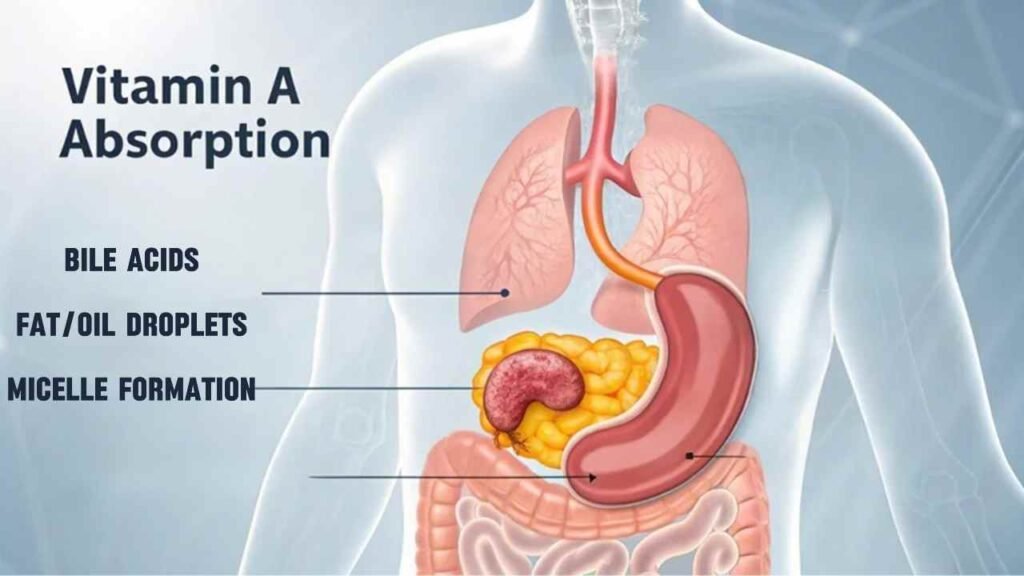Think getting enough Vitamin A is simple? Its journey in the body is complex. Let's explore how Vitamin A is absorbed and what affects its function.
Vitamin A absorption requires dietary fat and involves bile salts. It interacts with other fat-soluble vitamins (D, E, K), zinc, certain health conditions, medications, and is affected by food processing.
Understanding how a nutrient like Vitamin A works inside the body helps us appreciate why quality and proper formulation are so important.
Does dietary fat intake influence how well the body absorbs Vitamin A?
Need fat to absorb Vitamin A? Does low-fat mean low absorption? Let's confirm the role of fat.
Yes, absolutely. Vitamin A is fat-soluble, meaning dietary fat is essential for its absorption. Bile acids help emulsify fats, allowing Vitamin A to be absorbed effectively.
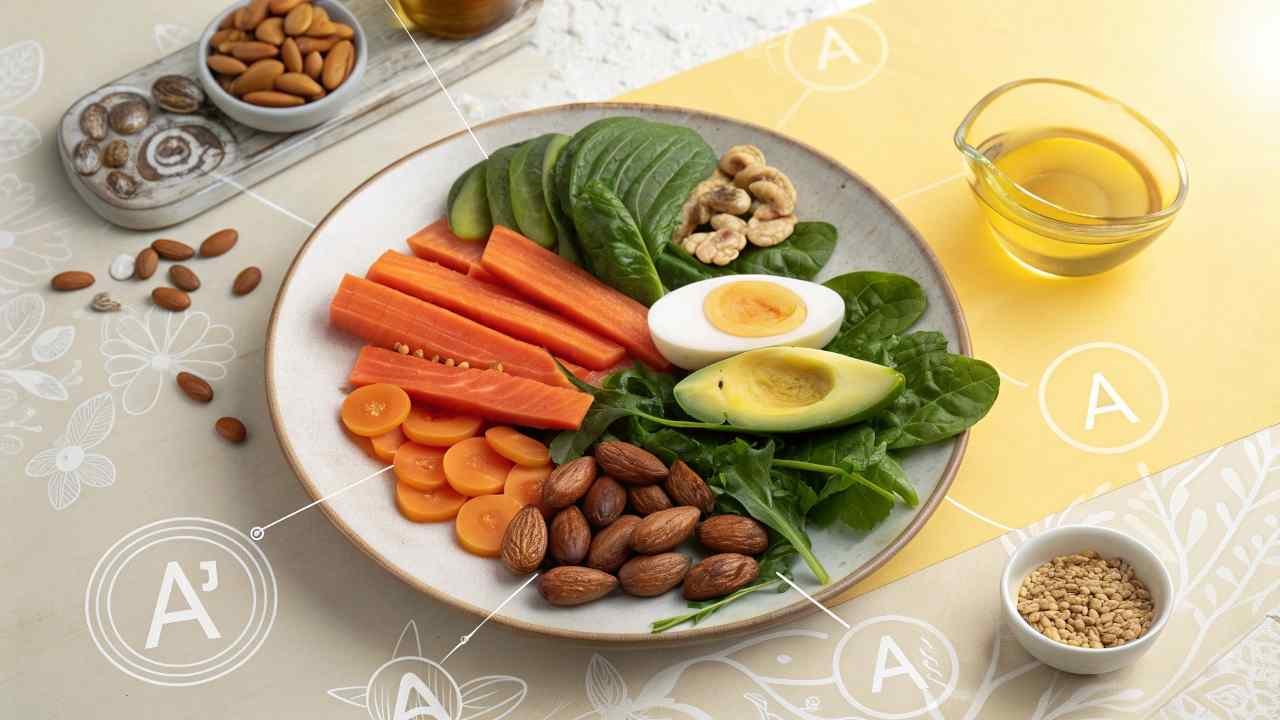
This is basic but crucial: No fat, poor absorption. Vitamin A dissolves in fat. Your gut needs fat to trigger bile release. Bile helps break down fats and package Vitamin A into tiny carriers called micelles1. These micelles transport Vitamin A to the gut wall for absorption. Then it’s packaged into chylomicrons2 and travels via lymph to the liver.
Very low-fat diets severely reduce Vitamin A uptake. This is why fortifying oils works well – the vitamin comes with the fat needed to absorb it.
Fat's Role Simplified:
| Why Fat Matters | What Fat Does | Without Enough Fat? |
|---|---|---|
| Solubility | Vitamin A dissolves in fat | Poor mixing |
| Bile Trigger | Fat signals bile release | Less bile |
| Micelle Formation | Fat + Bile package Vitamin A | Fewer carriers |
| Absorption | Fat needed for uptake | Low absorption |
Are there known interactions between Vitamin A and other fat-soluble vitamins?
Do vitamins compete with each other? Can taking too much of one affect another? Let's explore how Vitamin A interacts with Vitamins D, E, and K.
Yes, interactions exist. High intakes of one fat-soluble vitamin can interfere with the absorption or metabolism of others (e.g., high Vitamin E may affect Vitamin A; high Vitamin A may affect Vitamin K).
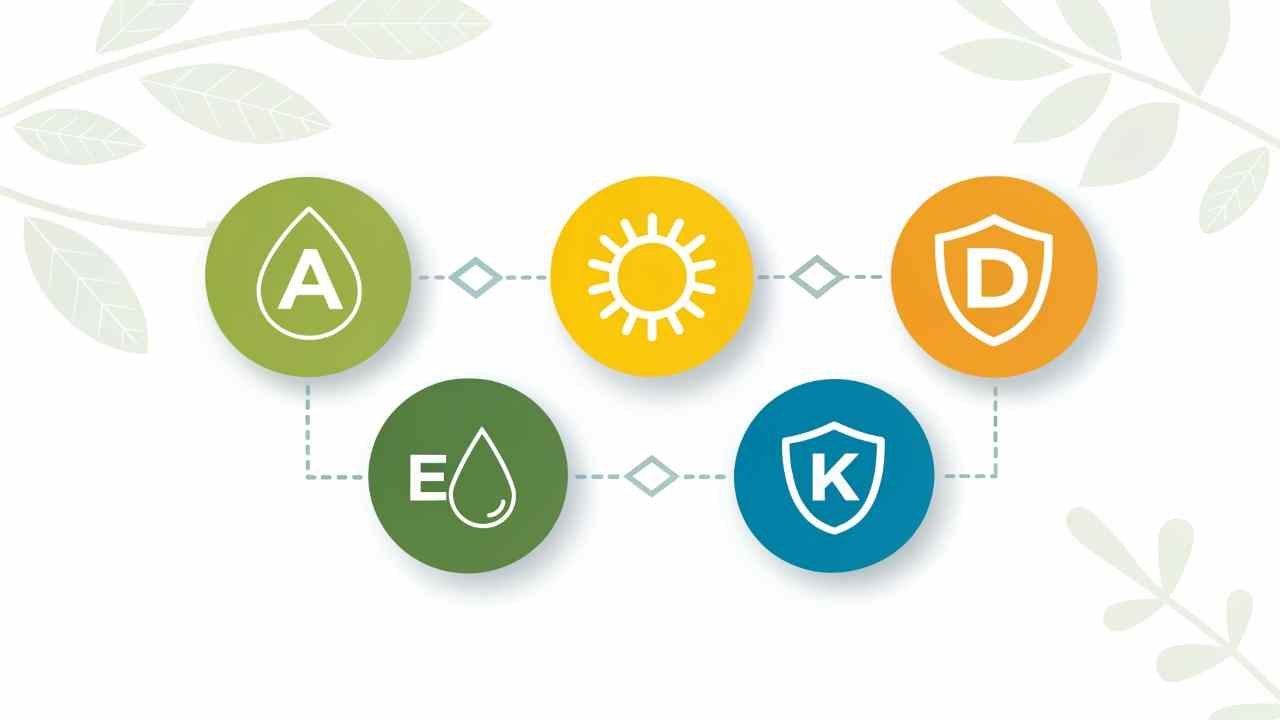
Since Vitamins A, D, E, and K all need fat for absorption, they can compete, especially at high supplemental doses.
Key Interactions:
- A & E: Vitamin E (antioxidant) helps protect Vitamin A. But very high E might interfere with A's absorption/storage. Balance is key.
- A & D: They interact in complex ways at the cellular level (gene regulation3). High A might negatively affect D’s function. Balance seems important.
- A & K: High Vitamin A intake can interfere with Vitamin K absorption and function (important for blood clotting).
Basically, these vitamins work together, and balance is better than mega-doses of just one.
Interaction Quick Guide:
| Interaction | Potential Issue with High Dose | Key Point |
|---|---|---|
| High E on A | Interference possible | E also protects A |
| High A on D | Interference possible | Balance matters |
| High A on K | Interference likely (absorption/function) | Clotting risk |
Can certain medications or health conditions affect Vitamin A levels or metabolism?
Can illness or drugs mess with Vitamin A? Who might be at risk? Let's identify key factors affecting Vitamin A status.
Yes. Conditions hurting fat absorption (Crohn's, Celiac, Cystic Fibrosis), liver disease, and drugs like Orlistat (fat blocker) or bile acid sequestrants can lower Vitamin A levels.

Factors Reducing Vitamin A Status:
- Fat Malabsorption Issues:
- Gut diseases (Crohn's, Celiac): Damage gut lining, reducing absorption.
- Pancreatic problems (Cystic Fibrosis): Less fat-digesting enzymes.
- Bile problems (Liver disease, gallbladder removal): Less fat emulsification.
- Liver Disease: The liver stores Vitamin A and makes its transport protein (RBP). Liver damage (e.g., from alcohol) impairs storage and transport.
- Medications:
- Orlistat (weight loss): Blocks fat absorption.
- Cholestyramine (cholesterol): Binds bile acids needed for absorption.
- Mineral oil (laxative - chronic use): Physical interference.
People with these conditions or on these drugs may need more Vitamin A or special monitoring.
Factors Summary:
| Factor Type | Examples | How it Affects Vitamin A |
|---|---|---|
| Health Issues | Gut diseases, Liver disease, Pancreatic issue | Reduces absorption or utilization |
| Medications | Orlistat, Bile Acid Sequestrants | Reduces absorption |
How does food processing or cooking impact the stability and bioavailability of Vitamin A?
Does cooking kill Vitamin A? How does factory processing affect it? Let's see how heat and handling change Vitamin A in food.
Heat, light, and oxygen destroy preformed Vitamin A (retinol/esters). But cooking can increase the body's ability to absorb carotenoids (like beta-carotene) from plants by breaking cell walls.
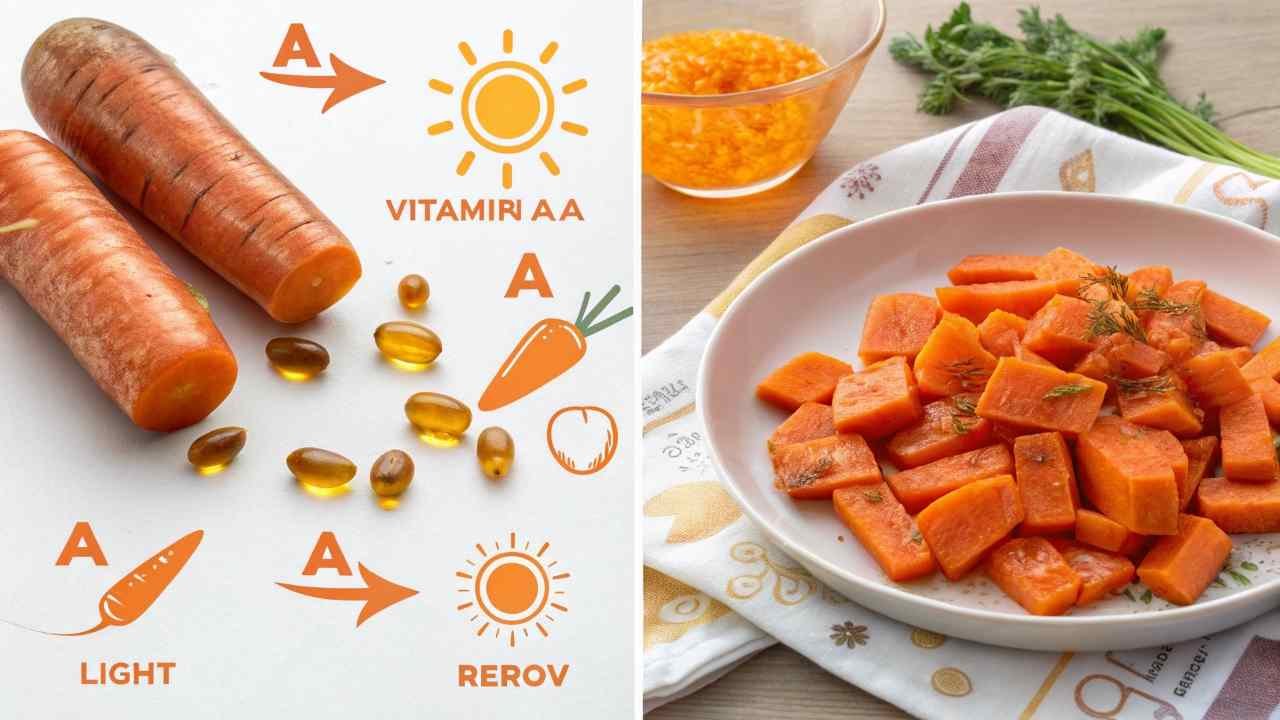
How you treat food matters for Vitamin A content.
- Preformed Vitamin A (Fortified foods, liver, dairy):
- Sensitive: Degrades with heat (especially high temps like frying), oxygen, and light.
- Protection: Antioxidants (like Vit E), encapsulation (powders), opaque/airtight packaging help preserve it. Gentle cooking is better.
- Provitamin A Carotenoids (Plants like carrots, spinach):
- Sensitivity: Also degrade with heat, light, oxygen.
- Bioavailability Boost: Cooking (especially with fat) helps absorption by breaking plant cell walls and releasing carotenoids4.
For fortified foods, manufacturers add extra Vitamin A (overage) to account for losses during processing and shelf life. Using stable forms and good packaging is key.
Processing/Cooking Impact:
| Factor | Effect on Preformed A | Effect on Carotenoids | Takeaway |
|---|---|---|---|
| Heat | Loss | Loss + Better Uptake | Minimize heat, cook plants gently |
| Oxygen/Light | Loss | Loss | Protect with packaging/antioxidants |
What role does zinc play in the body's utilization of Vitamin A?
Is zinc important for Vitamin A? How are they connected? Let's look at the link between this mineral and vitamin.
Zinc is crucial for using Vitamin A. The body needs zinc to make the protein (RBP) that carries Vitamin A in the blood and for an enzyme essential for vision.
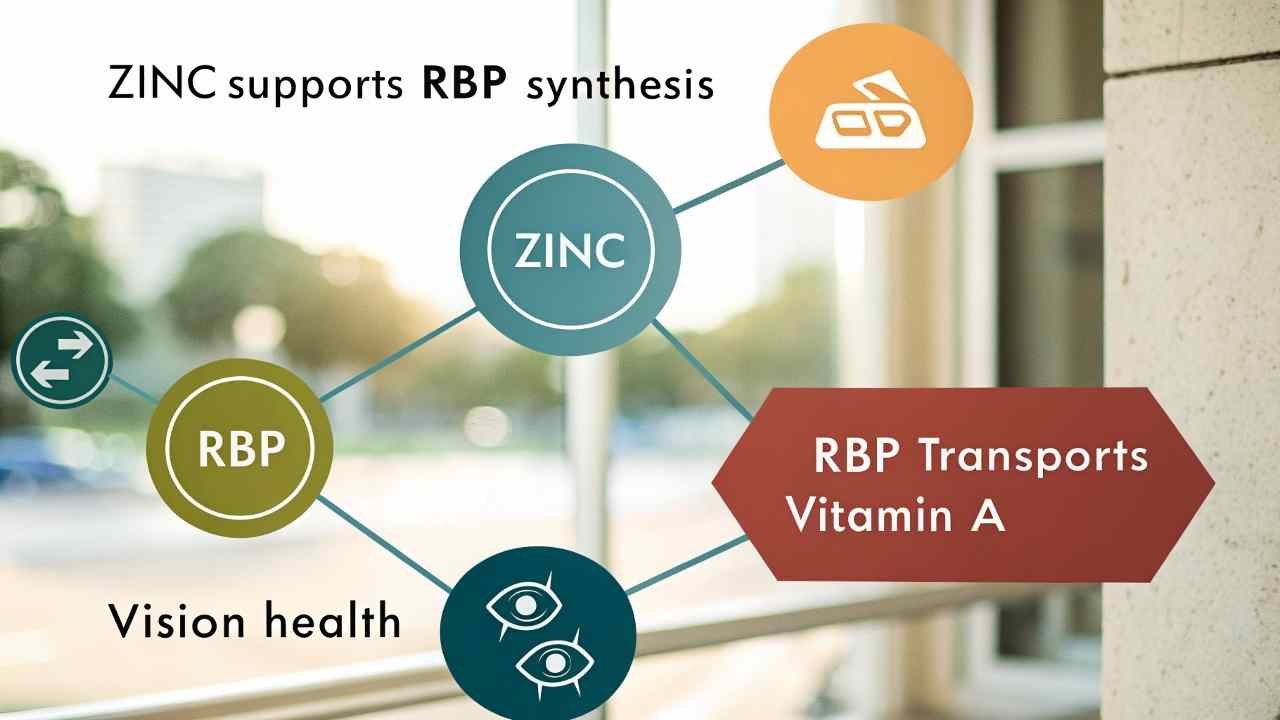
Zinc and Vitamin A work as a team. Without enough zinc, Vitamin A can't do its job properly, even if you eat enough.
How Zinc Helps Vitamin A:
- Transport: Zinc is needed for the liver to make Retinol-Binding Protein (RBP)5. RBP carries Vitamin A from the liver to where it's needed. Low zinc means low RBP, trapping Vitamin A in the liver.
- Vision: Zinc is part of the enzyme (retinol dehydrogenase) that converts Vitamin A into the form used for sight (retinal). Low zinc impairs this conversion, potentially causing poor night vision.
This means zinc deficiency can cause Vitamin A deficiency symptoms. In areas where malnutrition is common, both deficiencies often occur together, making health problems worse. Ensuring adequate zinc intake is important for Vitamin A to work effectively.
Zinc-Vitamin A Connection:
| Zinc Needed For... | Why It Matters for Vitamin A | If Zinc is Low... |
|---|---|---|
| RBP Production | Transports Vitamin A in blood | Vitamin A stuck in liver |
| Vision Enzyme | Activates Vitamin A for sight | Poor vision (e.g., night blind) |
Conclusion
Vitamin A needs fat for absorption and works closely with zinc. Its effectiveness is influenced by health, medicines, other vitamins (D, E, K), and how food is processed.
-
Exploring how micelles function can provide insights into the digestive process and nutrient uptake. ↩
-
Learning about chylomicrons can deepen your understanding of fat metabolism and its importance in health. ↩
-
Understanding gene regulation is crucial for insights into cellular functions and genetic disorders. Explore this link to deepen your knowledge. ↩
-
Exploring carotenoids can help you learn about their importance in your diet and how to incorporate them effectively. ↩
-
Understanding RBP is crucial for grasping its role in vitamin A transport and overall health. Explore this link for detailed insights. ↩

